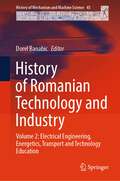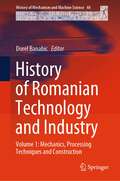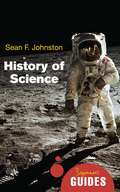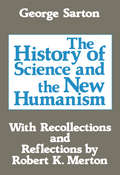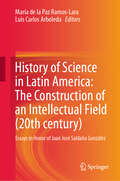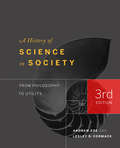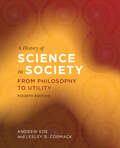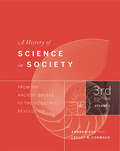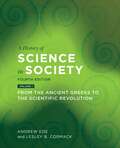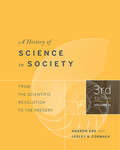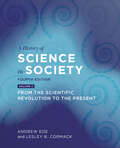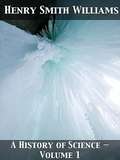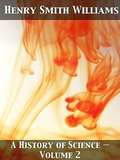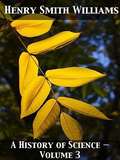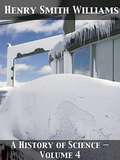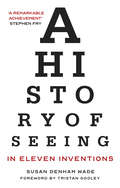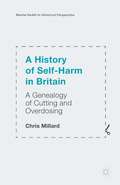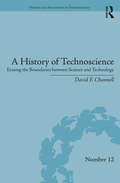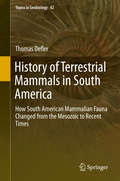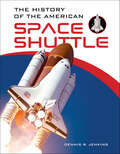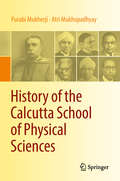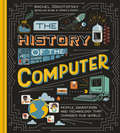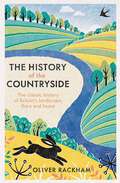- Table View
- List View
History of Romanian Technology and Industry: Volume 2: Electrical Engineering, Energetics, Transport and Technology Education (History of Mechanism and Machine Science #45)
by Dorel BanabicThis volume showcases the valuable achievements of the Romanian technology and industry worldwide. It started from the premise that the history of Romanian technique is scarcely known outside the borders of Romania. The main Romanian contributions to the world’s technological heritage are missing, except for a few names in the field of aviation, from the great encyclopedias and dictionaries published worldwide. This is due, among other reasons, to the insufficient promotion in widely spoken languages of the history of Romanian technology. The multidisciplinary approach of the volumes means that the field of technology had to be split into several branches. The present volume includes the following industries: electrical engineering, energy technology, biomedicine, maritime and rail transport, automotive industry, aviation. The history of engineering societies, of engineering education, of intellectual property, and of inventions, as well as a synopsis of the personalities of Romanian engineering have been tackled in separate chapters. For each field, are engaged the collaboration of authors who have already published a history of their field. Certain chapters were drafted with the aid of specialists who have played the part of policy makers in the elaboration of development strategies for Romania and who are familiar not only with the facts and the history of their field, but also with the ‘philosophy’ behind its development.
History of Romanian Technology and Industry: Volume 1: Mechanics, Processing Techniques and Construction (History of Mechanism and Machine Science #44)
by Dorel BanabicThis volume showcases the valuable achievements of the Romanian technology and industry worldwide. It started from the premise that the history of Romanian technique is scarcely known outside the borders of Romania. The main Romanian contributions to the world’s technological heritage are missing, except for a few names in the field of aviation, from the great encyclopedias and dictionaries published worldwide. This is due, among other reasons, to the insufficient promotion in widely spoken languages of the history of Romanian technology. The multidisciplinary approach of the volumes means that the field of technology had to be split into several branches. The present volume includes the following industries: mining, metallurgy, oil, natural gas, machine building, agricultural machinery, military, textiles, and construction. Folk technology, the formation of the industrial system, and mechanics are tackled in separate chapters. For each field, are engaged the collaboration of authors who have already published a history of their field. Certain chapters were drafted with the aid of specialists who have played the part of policy makers in the elaboration of development strategies for Romania and who are familiar not only with the facts and the history of their field, but also with the ‘philosophy’ behind its development.
History of Science: A Beginner's Guide (Beginner's Guides)
by Sean F. JohnstonEmploying intellectual history, philosophy, and social studies, Sean Johnston offers a unique appraisal of the history of science and the nature of the evolving discipline. Science is all-encompassing and contentious. Based on its past, where might it lead in the twenty-first century? Sean F. Johnston is a reader in the History of Science and Technology at the University of Glasgow.
The History of Science and the New Humanism
by Michael NovakIn this classic work, the foremost historian of science in our time, George Sarton, sums up his reflections on the role of science and of the humanities in our culture. Voicing his opposition to the old-fashioned humanists on the one hand, and to the 'uneducated' men of science and technicians on the other, Sarton points out to the former that the humanities without scientific are essentially incomplete. He warns the latter that without history, without philosophy, without arts and letters, without a living religion, human life on this planet would cease to be worthwhile.After outlining his 'Faith of a Humanist' in the opening section, Sarton goes on to analyze 'The History of Science and the History of Civilization,' to discuss the progress of scientific thought since ancient times in 'East and West,' and to propose the solution for the educational and cultural crisis of our time in 'The New Humanism' and in 'The History of Science and the Problems of Today.' He concludes not only that science is a source of technological development that has changed the face of the earth and has convulsed our lives for good and evil, but that it nonetheless affords the best means of understanding the world, its people, and the multitude of their relationships. 'Science is the conscience of mankind.'Included in this edition is Robert M. Merton's address before the Sarton Centennial meeting of November 1984. It is a stunning tour de force in its own right, providing insights into Sarton, teaching and research at Harvard in the 1930s, and the personal interaction between Sarton the mentor, and Merton the pupil. The essay supplements May Sarton's earlier 'Informal Portrait of George Sarton.'
History of Science in Latin America (20th century): Essays in Honor of Juan José Saldaña González
by María de la Paz Ramos-Lara Luis Carlos ArboledaThis book provides a unique analysis of how the History of Science became institutionalized in Latin America during the last two decades of the 20th century. It examines the establishment of the first Latin American community in the History of Science and its connections with the international community and various international institutions, such as the International Union of History and Philosophy of Science and Technology / Division of History of Science and Technology (IUHPST/DHST). The authors are the same scholars who have been involved in several activities and strategies to professionalize and institutionalize this field in Latin America. They explore the impact of Western educational institutions and theoretical and methodological perspectives on the introduction of the History of Science in several Latin American nations. The book examines the two-way movement of European scholars to Latin America and Latin American students mainly to France. At that time, the organization of congresses in France, Spain, the United States, and other European countries encouraged the participation of Latin American historians of science. Notable events include the Science and Empires congress in Paris (1990), the Ciencia, descubrimiento y mundo colonial conference in Madrid (1991), and the International Congresses of History of Science and Technology (ICHST). The authors refer to seven Latin Americans who signed the Declaration of Bucharest (1981) to promote the history of sciences in their countries. This initiative led to the establishment of the Latin American Society for the History of Science and Technology (LASHST) in 1982, under the leadership of Juan José Saldaña, director of Quipu and Cuadernos de Quipu. With his leadership, existing national societies were reactivated, and new ones were created, up to ten in four years: Argentina, Brazil, Colombia, Mexico, Chile, Peru, Venezuela, Costa Rica, Ecuador, and Cuba. This effort internationally legitimized Latin American scientific practice, culminating in celebrating the XXI ICHST in Mexico City in 2001. He founded the International Association for Scientific Cultural Diversity (IASCUD) and became the first Latin American to serve as Secretary General of IUHPST/DHS from 2001 to 2005. Through his various actions and activities, Saldaña and the LASHST community were able to promote the institutionalization of the History of Science in Latin America. This book pays a well-deserved tribute to his efforts.
A History of Science in Society: From Philosophy to Utility, Third Edition
by Lesley Cormack Andrew EdeA History of Science in Society is a concise overview that introduces complex ideas in a non-technical fashion. Ede and Cormack trace the history of the changing place of science in society and explore the link between the pursuit of knowledge and the desire to make that knowledge useful.New topics in this edition include astronomy and mathematics in ancient Mayan society, science and technology in ancient India and China, and Islamic cartography. New "Connections" features provide in-depth exploration of the ways science and society interconnect. The text is accompanied by 55 colour maps and diagrams, and 8 colour plates highlighting key concepts and events. Essay questions, chapter timelines, a further readings section, and an index provide additional support for students. A companion reader edited by the authors, A History of Science in Society: A Reader, is also available.
A History of Science in Society: From Philosophy to Utility, Fourth Edition
by Andrew Ede Lesley B. CormackIn A History of Science in Society, Ede and Cormack trace the history of the changing place of science in society and explore the link between the pursuit of knowledge and the desire to make that knowledge useful. The fourth edition of this bestselling textbook brings the narrative right up to the present day by incorporating the COVID-19 pandemic. The edition also adds content on Indigenous and non-western science as well as five new "Connections" case study features, including one on the scientist and poet Omar Khayyam. The text is accompanied by 100 images and maps and a colour insert showing off key moments in the history of science. Essay questions, chapter timelines, a further readings section, and an index provide additional support for students.
A History of Science in Society, Volume I: From The Ancient Greeks To The Scientific Revolution, Third Edition
by Lesley B. Cormack Andrew EdeA History of Science in Society is a concise overview that introduces complex ideas in a non-technical fashion. Ede and Cormack trace the history of the changing place of science in society and explore the link between the pursuit of knowledge and the desire to make that knowledge useful. Volume I covers the origins of natural philosophy in the ancient world to the Scientific Revolution. New topics in this edition include astronomy and mathematics in ancient Mayan society, science and technology in ancient India and China, and Islamic cartography. New "Connections" features provide in-depth exploration of the ways science and society interconnect. The text is accompanied by 27 colour maps and diagrams, and 4 colour plates highlighting key concepts and events. Essay questions, chapter timelines, a further readings section, and an index provide additional support for students. A companion reader edited by the authors, A History of Science in Society: A Reader, is also available.
A History of Science in Society, Volume I: From Philosophy to Utility, Fourth Edition
by Andrew Ede Lesley B. CormackIn A History of Science in Society, Ede and Cormack trace the history of the changing place of science in society and explore the link between the pursuit of knowledge and the desire to make that knowledge useful. Volume I covers the origins of natural philosophy in the ancient world to the scientific revolution. The fourth edition of this bestselling textbook adds content on non-Western science and a new "Connections" case study feature on the scientist and poet Omar Khayyam. The text is accompanied by over fifty images and maps that illustrate key developments in the history of science. Essay questions, chapter timelines, a further readings section, and an index provide additional support for students.
A History of Science in Society, Volume II: From the Scientific Revolution to the Present, Third Edition
by Lesley B. Cormack Andrew EdeA History of Science in Society is a concise overview that introduces complex ideas in a non-technical fashion. Ede and Cormack trace the history of the changing place of science in society and explore the link between the pursuit of knowledge and the desire to make that knowledge useful. Volume II covers from the Scientific Revolution until the present day. New topics in this edition include science and the corporate world, the regulation of science and technology, and climate change. New "Connections" features provide in-depth exploration of the ways science and society interconnect. The text is accompanied by 38 colour maps and diagrams, and 4 colour plates highlighting key concepts and events. Essay questions, chapter timelines, a further readings section, and an index provide additional support for students. A companion reader edited by the authors, A History of Science in Society: A Reader, is also available.
A History of Science in Society, Volume II: From Philosophy to Utility, Fourth Edition
by Andrew Ede Lesley B. CormackIn A History of Science in Society, Ede and Cormack trace the history of the changing place of science in society and explore the link between the pursuit of knowledge and the desire to make that knowledge useful. Volume II covers the period from the scientific revolution to the present day. The fourth edition of this bestselling textbook brings the narrative right up into the twenty-first century by incorporating the COVID-19 pandemic. The edition also adds content on Indigenous and non-Western science as well as three new "Connections" case study features. The text is accompanied by over sixty images and maps that illustrate key developments in the history of science. Essay questions, chapter timelines, a further readings section, and an index provide additional support for students.
A History of Science -- Volume 1
by Edward Huntington Williams Henry Smith WilliamsShould the story that is about to be unfolded be found to lack interest, the writers must stand convicted of unpardonable lack of art. <P> <P> Nothing but dulness in the telling could mar the story, for in itself it is the record of the growth of those ideas that have made our race and its civilization what they are; of ideas instinct with human interest, vital with meaning for our race; fundamental in their influence on human development; part and parcel of the mechanism of human thought on the one hand, and of practical civilization on the other. Such a phrase as “fundamental principles” may seem at first thought a hard saying, but the idea it implies is less repellent than the phrase itself, for the fundamental principles in question are so closely linked with the present interests of every one of us that they lie within the grasp of every average man and woman— nay, of every well-developed boy and girl. These principles are not merely the stepping-stones to culture, the prerequisites of knowledge— they are, in themselves, an essential part of the knowledge of every cultivated person
A History of Science -- Volume 2
by Edward Huntington Williams Henry Smith WilliamsThe studies of the present book cover the progress of science from the close of the Roman period in the fifth century A. D. to about the middle of the eighteenth century. In tracing the course of events through so long a period, a difficulty becomes prominent which everywhere besets the historian in less degree— a difficulty due to the conflict between the strictly chronological and the topical method of treatment. <P> <P> We must hold as closely as possible to the actual sequence of events, since, as already pointed out, one discovery leads on to another. But, on the other hand, progressive steps are taken contemporaneously in the various fields of science, and if we were to attempt to introduce these in strict chronological order we should lose all sense of topical continuity.
A History of Science -- Volume 3
by Edward Huntington Williams Henry Smith WilliamsWith the present book we enter the field of the distinctively modern. There is no precise date at which we take up each of the successive stories, but the main sweep of development has to do in each case with the nineteenth century. <P> <P> We shall see at once that this is a time both of rapid progress and of great differentiation. We have heard almost nothing hitherto of such sciences as paleontology, geology, and meteorology, each of which now demands full attention. Meantime, astronomy and what the workers of the elder day called natural philosophy become wonderfully diversified and present numerous phases that would have been startling enough to the star-gazers and philosophers of the earlier epoch.
A History of Science -- Volume 4
by Edward Huntington Williams Henry Smith WilliamsAS regards chronology, the epoch covered in the present volume is identical with that viewed in the preceding one. But now as regards subject matter we pass on to those diverse phases of the physical world which are the field of the chemist, and to those yet more intricate processes which have to do with living organisms. <P> <P> So radical are the changes here that we seem to be entering new worlds; and yet, here as before, there are intimations of the new discoveries away back in the Greek days. The solution of the problem of respiration will remind us that Anaxagoras half guessed the secret; and in those diversified studies which tell us of the Daltonian atom in its wonderful transmutations, we shall be reminded again of the Clazomenian philosopher and his successor Democritus.
A History of Seeing in Eleven Inventions: A History of Seeing
by Susan Denham Wade Tristan Gooley'A remarkable achievement' - Stephen FryIn 2015 #thedress captured the world’s imagination. Was the dress in the picture white and gold or blue and black? It inspired the author to ask: if people in the same time and place can see the same thing differently, how did people in distant times and places see the world?Jam-packed with fascinating stories, facts and insights and impeccably researched, A History of Seeing in Eleven Inventions investigates the story of seeing from the evolution of eyes 500 million years ago to the present day. Time after time, it reveals, inventions that changed how people saw the world ended up changing it altogether.Twenty-first-century life is more visual than ever, and seeing overwhelmingly dominates our senses.Can our eyes keep up with technology? Have we gone as far as the eye can see?
A History of Self-Harm in Britain: A Genealogy of Cutting and Overdosing (Mental Health in Historical Perspective)
by Chris MillardThis book is open access under a CC BY license and charts the rise and fall of various self-harming behaviours in twentieth-century Britain. It puts self-cutting and overdosing into historical perspective, linking them to the huge changes that occur in mental and physical healthcare, social work and wider politics.
A History of Technoscience: Erasing the Boundaries between Science and Technology (History and Philosophy of Technoscience)
by David F. ChannellAre science and technology independent of one another? Is technology dependent upon science, and if so, how is it dependent? Is science dependent upon technology, and if so how is it dependent? Or, are science and technology becoming so interdependent that the line dividing them has become totally erased? This book charts the history of technoscience from the late nineteenth century to the end of the twentieth century and shows how the military–industrial–academic complex and big science combined to create new examples of technoscience in such areas as the nuclear arms race, the space race, the digital age, and the new worlds of nanotechnology and biotechnology.
History of Terrestrial Mammals in South America: How South American Mammalian Fauna Changed From The Mesozoic To Recent Times (Topics in Geobiology #42)
by Thomas DeflerThis book takes a non-technical approach in covering the evolution of South American mammalian fauna throughout geological history, and discusses how South America has changed due to mammalian invasions. Unlike other works on the subject, this book attempts to answer several crucial questions that often go unmentioned together in one cohesive monograph. What was the fauna like before the American interchange? What were the origins of the now-extinct groups when northern species arrived and out-competed them? How did the modern mammalian fauna come into being with such disparate animal groups? This information is given from a historical perspective throughout the book's 15 chapters, and is presented in an easily graspable fashion by mostly avoiding technical language. The book is written for academics, scientists and scholars engaged in paleontology, zoology and evolutionary biology, but may also appeal to a larger audience of general readers interested in mammalian evolution. The book begins with an introduction, describing the tools necessary to interpret the evolutionary history of South American mammals in geological terms and some of the early people who helped found South American mammalian paleontology. Chapter 2 describes the Mesozoic first mammals of Gondwana and what we are learning about them, dominant before the K/T extinction event. Then chapters 3 through 8 cover the Cenozoic, or "Age of Mammals", highlighting the major mammalian groups of South America that replaced the earlier mammals of Gondwana. These groups include the marsupials, native ungulates, the xenarthrans (armadillos, anteaters, sloths), the caviomorphs (rodents), and the platyrrhine monkeys. Chapters 9 and 10 address the Antarctic La Meseta fossils and the Colombian La Venta fossil faunal assemblages. Chapter 11 discusses the neotropical mammals that invaded the Caribbean Islands, and illustrates the influence South America has had on adjacent faunas. Chapter 12 describes the origin of the Amazon River and the role it has played in the evolution of the mammals and other flora and fauna. Chapter 13 tells the story of the Great American Biotic Interchange (GABI), and chapter 14 follows this up with a discussion of the Pleistocene mammal communities and their eventual extinction. Chapter 15 concludes the text by discussing the modern mammals of South America, and how despite the extensive Pleistocene extinctions there is still a lot of mammalian diversity in South America.
The History of the American Space Shuttle
by Dennis R. JenkinsDetailed history of the American Space Shuttle Program from award-winning NASA insiderEach mission is reviewed from its early inception to delivering the remaining vehicles to their final display sitesCovers the history of reusable winged spacecraft from the 1920s throughout the final mission of the American space shuttle
History of the Calcutta School of Physical Sciences
by Purabi Mukherji Atri MukhopadhyayThis book highlights the role of Sir Asutosh Mookerjee, founder of the Calcutta school of physics and the Calcutta Mathematical Society, and his talented scholars – Sir C.V. Raman, D.M. Bose, S.N. Bose, M.N. Saha, Sir K.S. Krishnan and S.K. Mitra – all of whom played a significant role in fulfilling their goal of creating an outstanding school of physical sciences in the city of Calcutta. The main objective of the book is to bring to the fore the combined contributions of the greatest physicists of India, who in the colonial period worked with practically no modern amenities and limited financial resources, but nonetheless with total dedication and self-confidence, which is unmatched in today’s world. The book presents the golden age of the physical sciences in India in compact form; in addition, small anecdotes, mostly unknown to many, have been brought the forefront. The book consists of 10 chapters, which include papers by these distinguished scientists along with detailed accounts of their academic lives and main research contributions, particularly during their time in Calcutta. A synopsis of the contents is provided in the introductory chapter. In the following chapters, detailed discussions are presented in straightforward language. The complete bibliographies of the great scientists have been added at the end. This book will be of interest to historians, philosophers of science, linguists, anthropologists, students, research scholars and general readers with a love for the history of science.
The History of the Computer: People, Inventions, and Technology that Changed Our World
by Rachel IgnotofskyA strikingly illustrated overview of the computing machines that have changed our world—from the abacus to the smartphone—and the people who made them, by the New York Times bestselling author and illustrator of Women in Science.Computers are everywhere and have impacted our lives in so many ways. But who created them, and why? How have they transformed the way that we interact with our surroundings and each other?Packed with accessible information, fun facts, and discussion starters, this charming and art-filled book takes you from the ancient world to the modern day, focusing on important inventions, from the earliest known counting systems to the sophisticated algorithms behind AI. The History of the Computer also profiles a diverse range of key players and creators—from An Wang and Margaret Hamilton to Steve Jobs and Sir Tim Berners-Lee—and illuminates their goals, their intentions, and the impact of their inventions on our everyday lives. This entertaining and educational journey will help you understand our most important machines and how we can use them to enhance the way we live. You&’ll never look at your phone the same way again!
The History of the Countryside: The Classic History Of Britain's Landscape, Flora And Fauna
by Dr Oliver RackhamFrom its earliest origins to the present day, this award-winning, beautifully written book describes the endlessly changing character of Britain's countryside.'A classic' Richard MabeyExploring the natural and man-made features of the land - fields, highways, hedgerows, fens, marshes, rivers, heaths, coasts, woods and wood pastures - he shows conclusively and unforgettably how they have developed over the centuries. In doing so, he covers a wealth of related subjects to provide a fascinating account of the sometimes subtle and sometimes radical ways in which people, fauna, flora, climate, soils and other physical conditions have played their part in the shaping of the countryside.'One thing is certain: no one would be wise to write further on our natural history, or to make films about it, without thinking very hard about what is contained in these authoritative pages' COUNTRY LIFE
The History of the Countryside
by Oliver RackhamFrom its earliest origins to the present day, this award-winning, beautifully written book describes the endlessly changing character of Britain's countryside.'A classic' Richard MabeyExploring the natural and man-made features of the land - fields, highways, hedgerows, fens, marshes, rivers, heaths, coasts, woods and wood pastures - he shows conclusively and unforgettably how they have developed over the centuries. In doing so, he covers a wealth of related subjects to provide a fascinating account of the sometimes subtle and sometimes radical ways in which people, fauna, flora, climate, soils and other physical conditions have played their part in the shaping of the countryside.'One thing is certain: no one would be wise to write further on our natural history, or to make films about it, without thinking very hard about what is contained in these authoritative pages' COUNTRY LIFE
